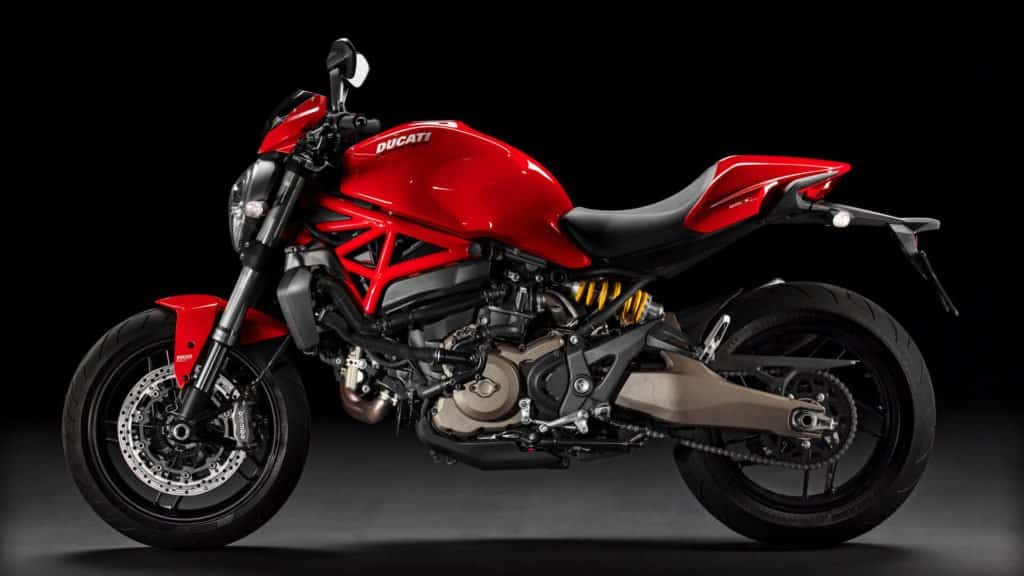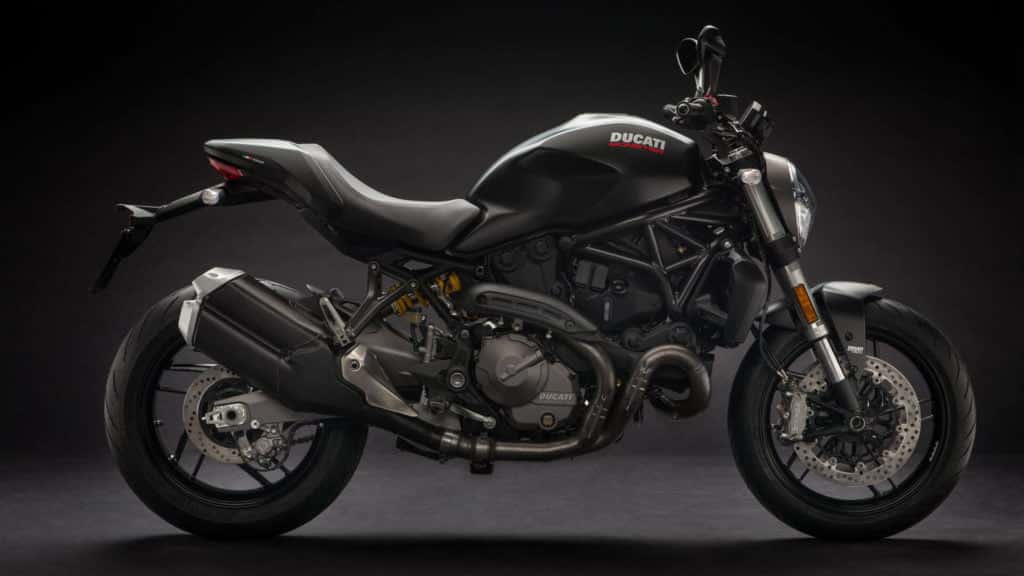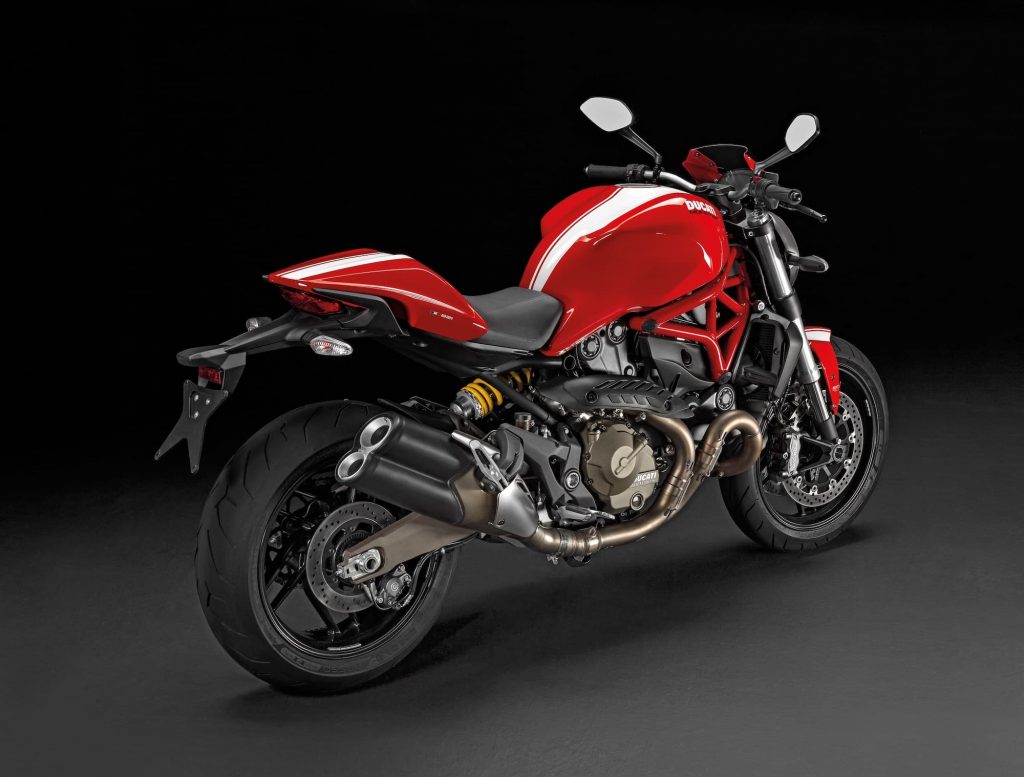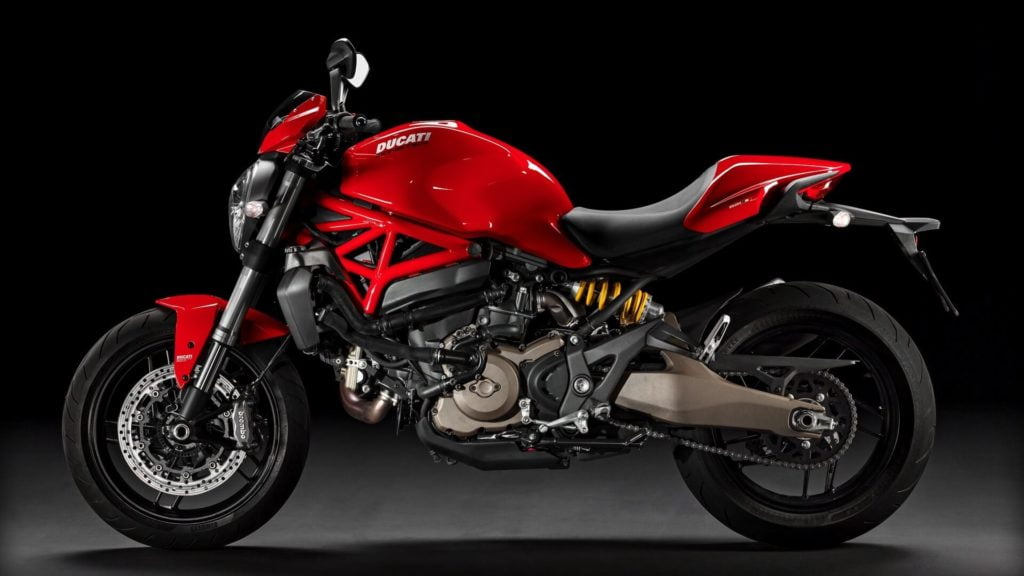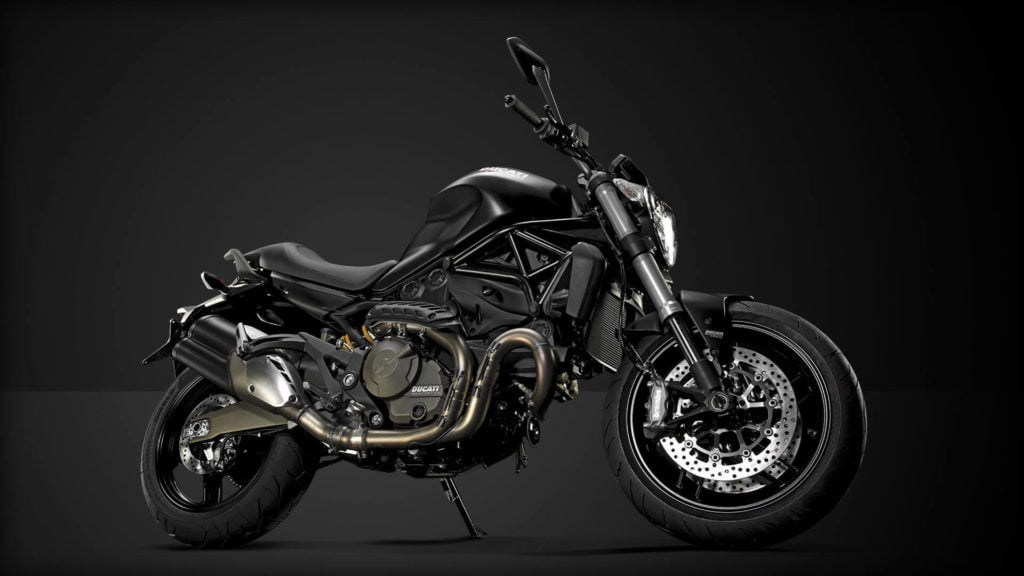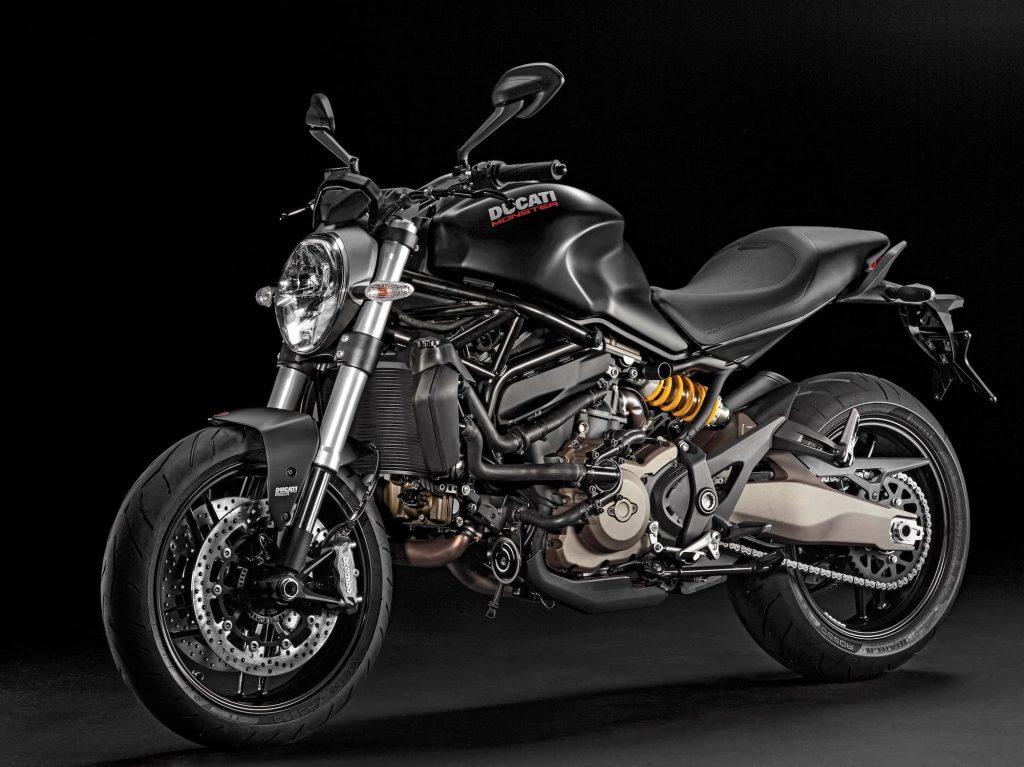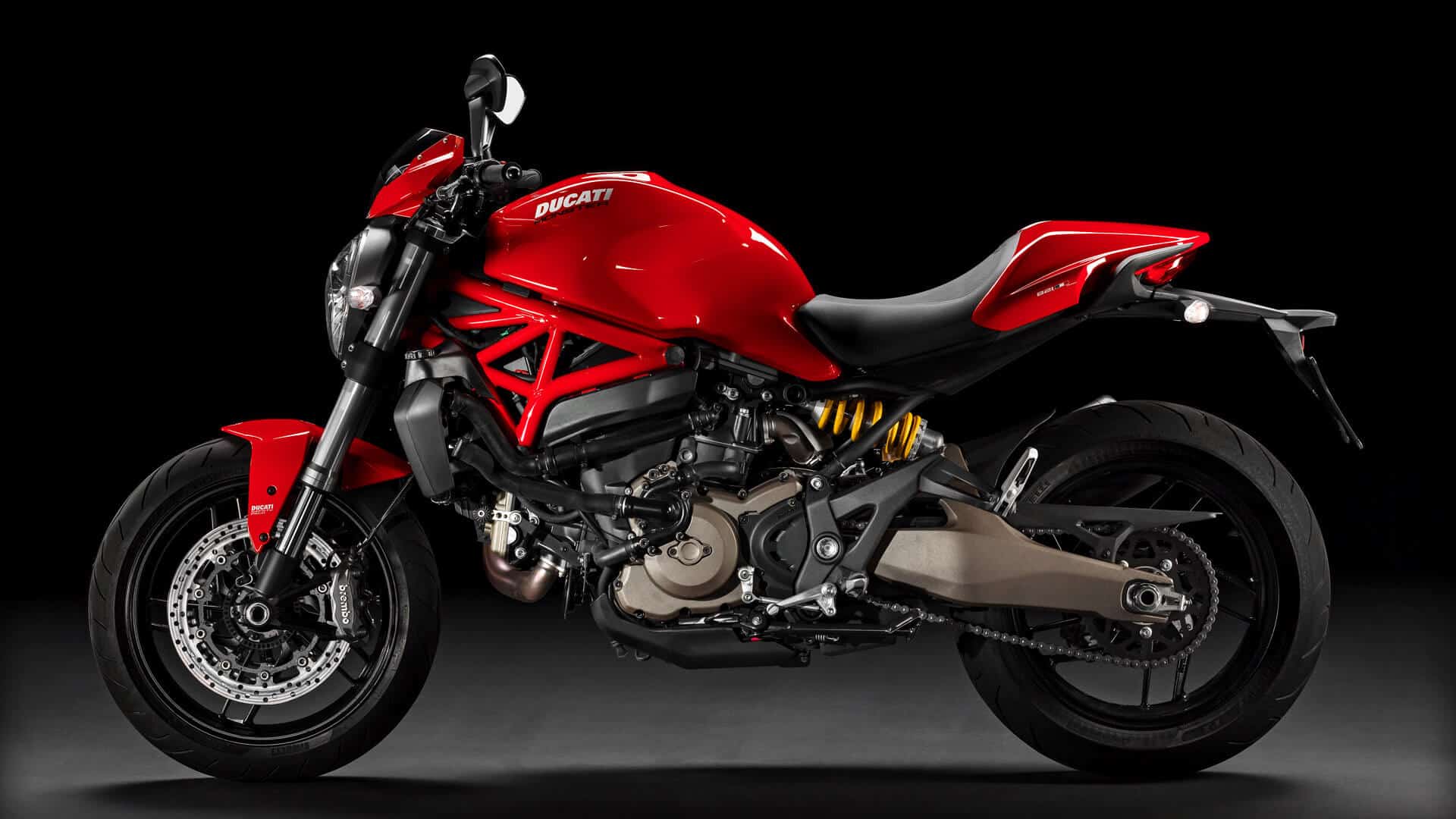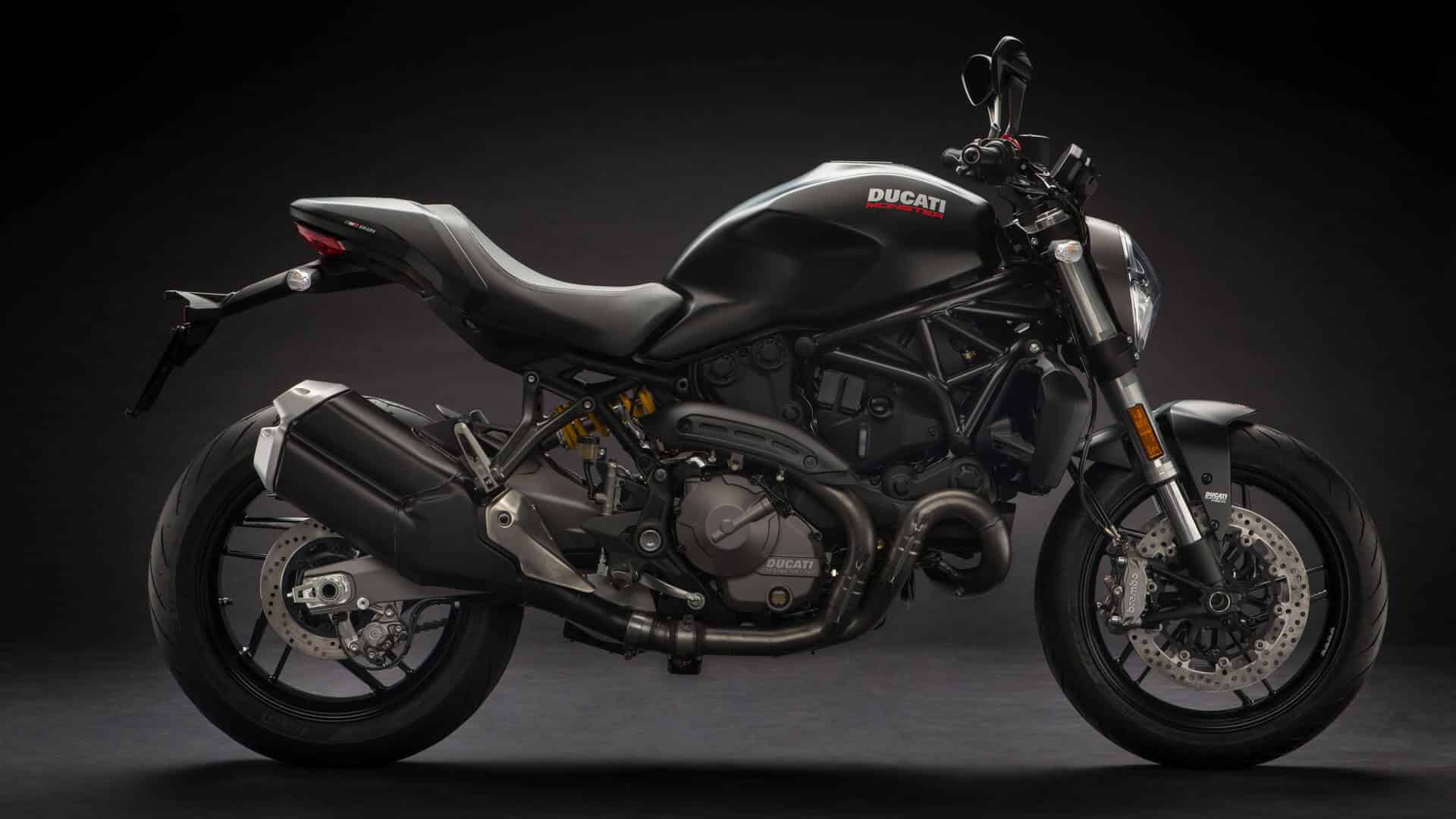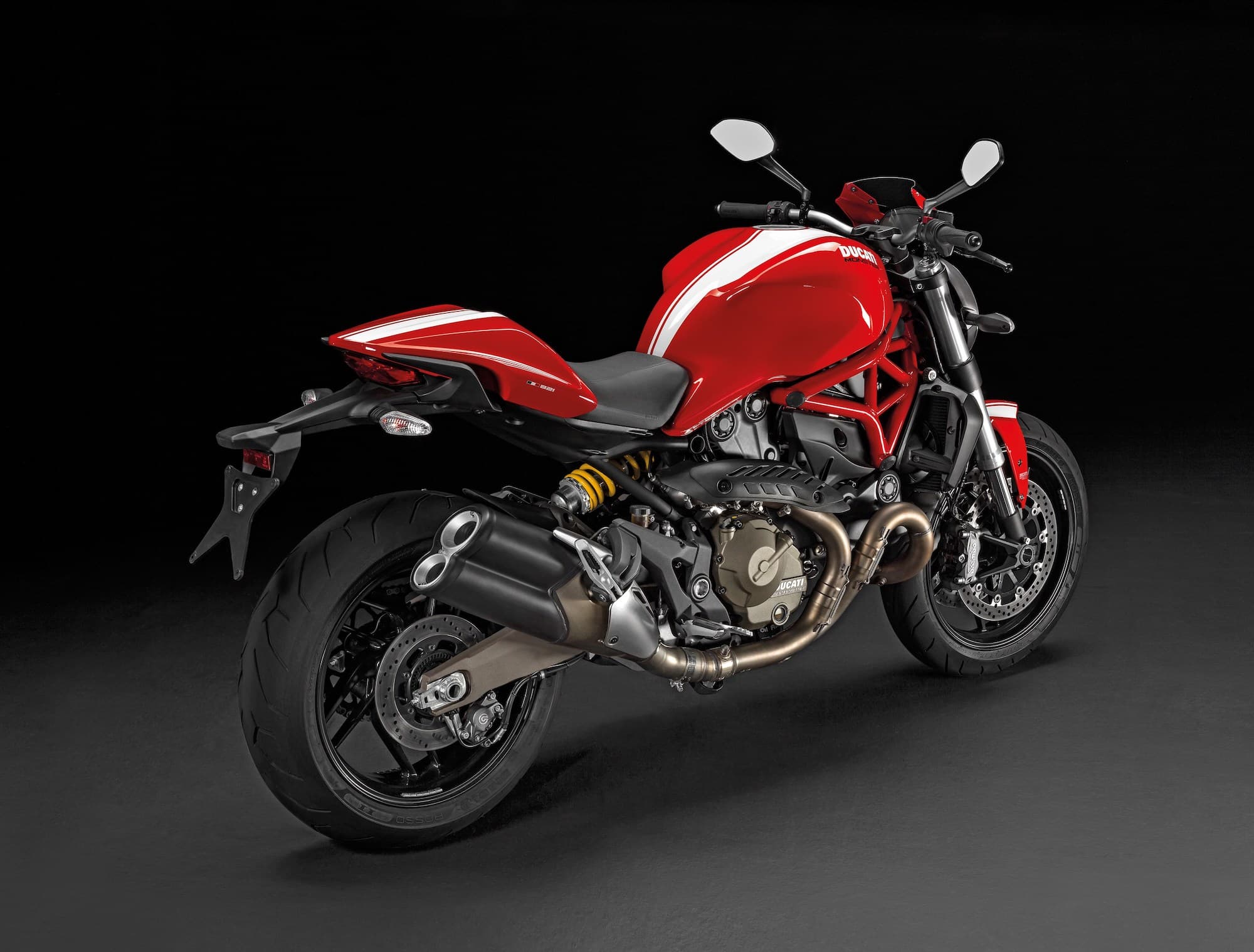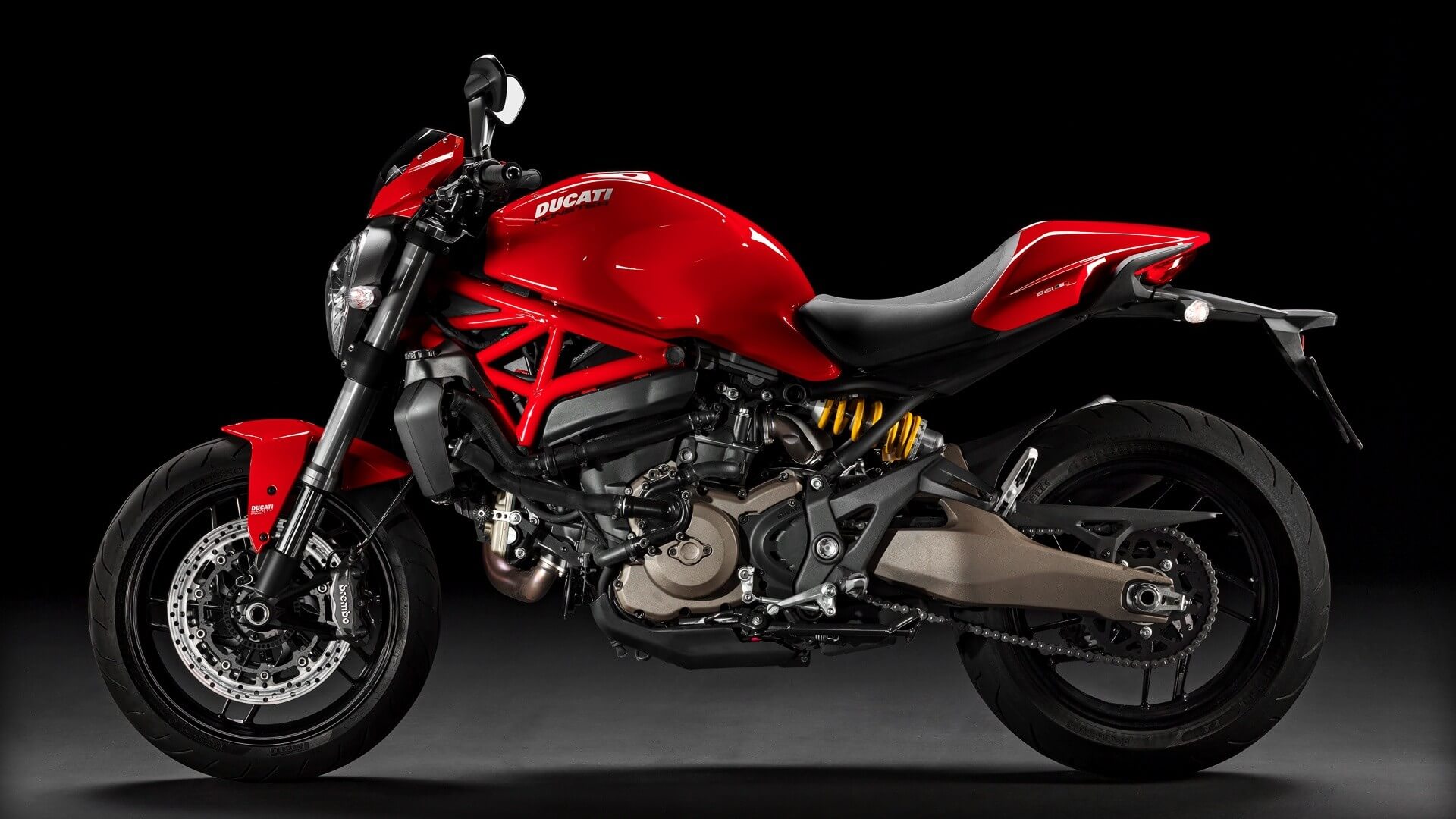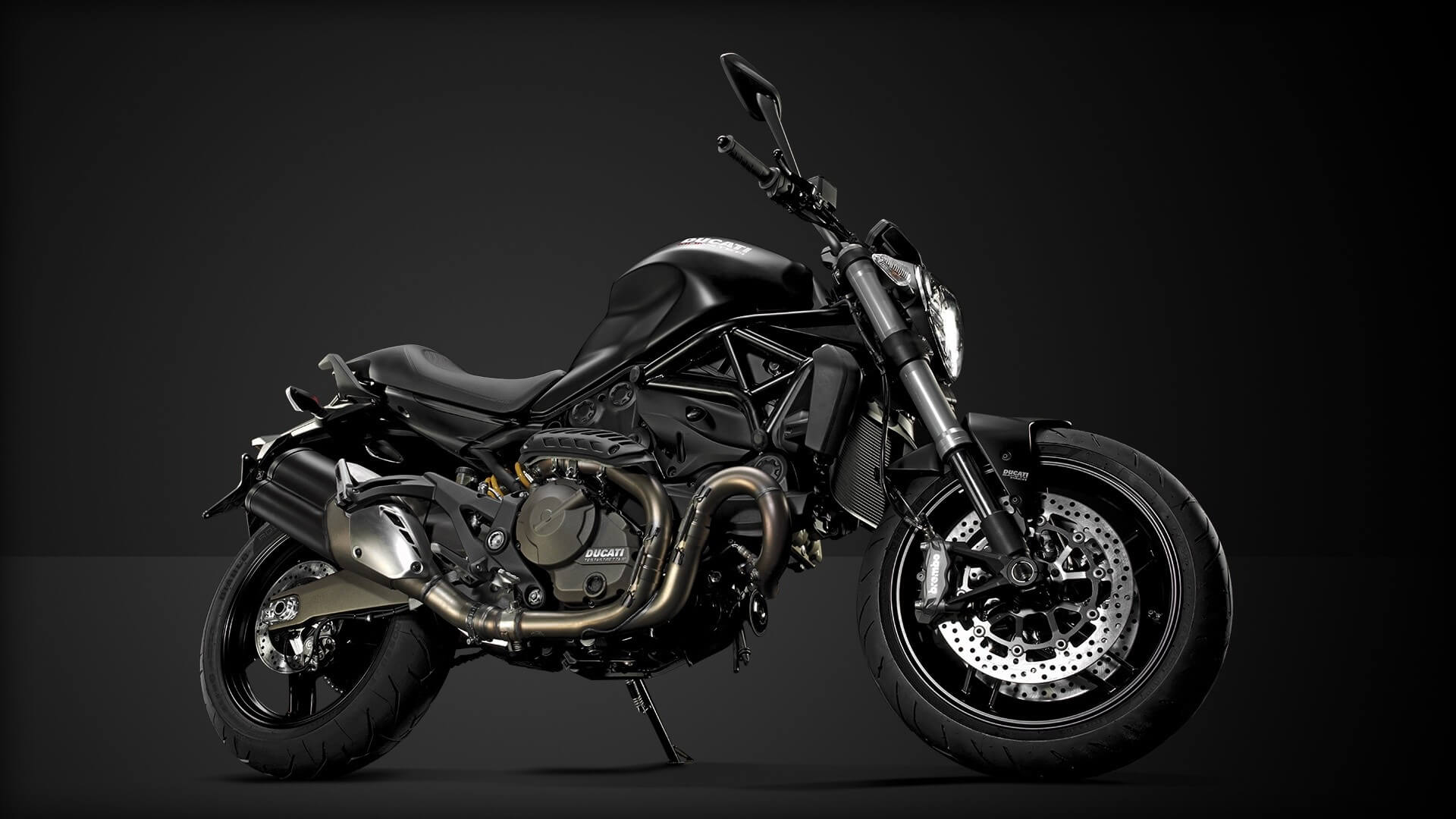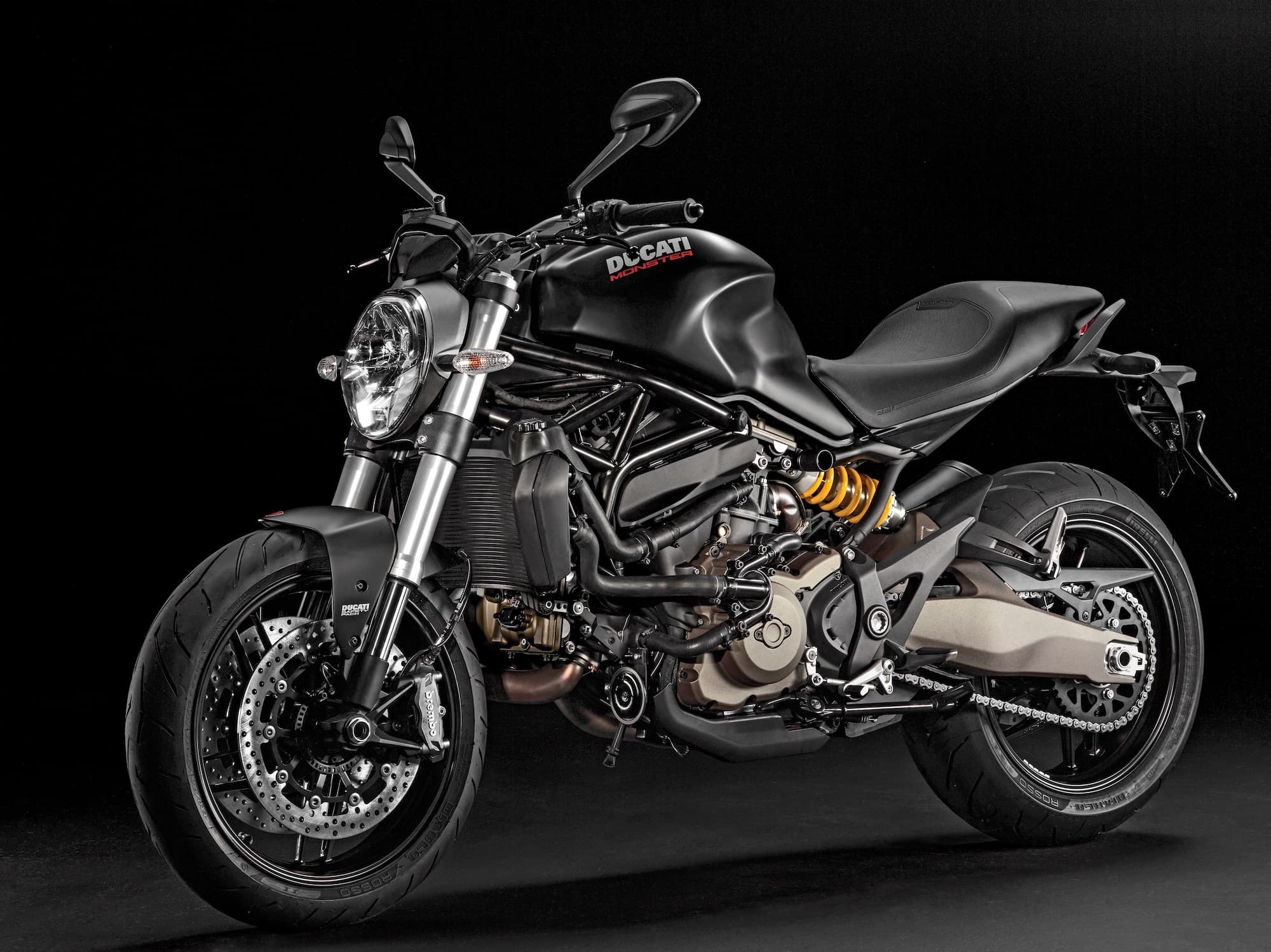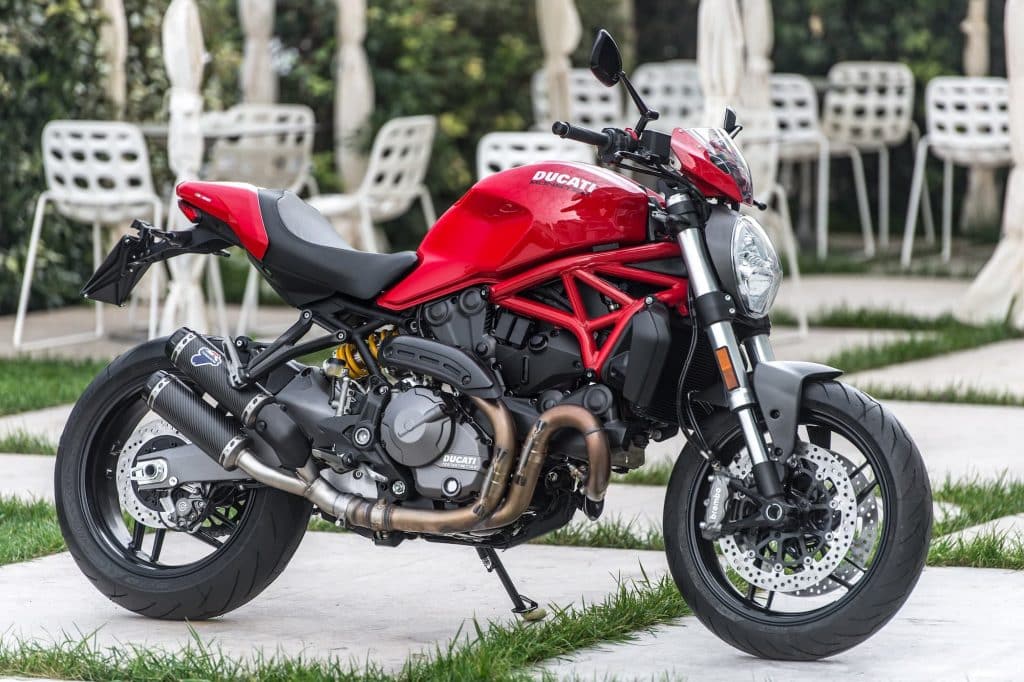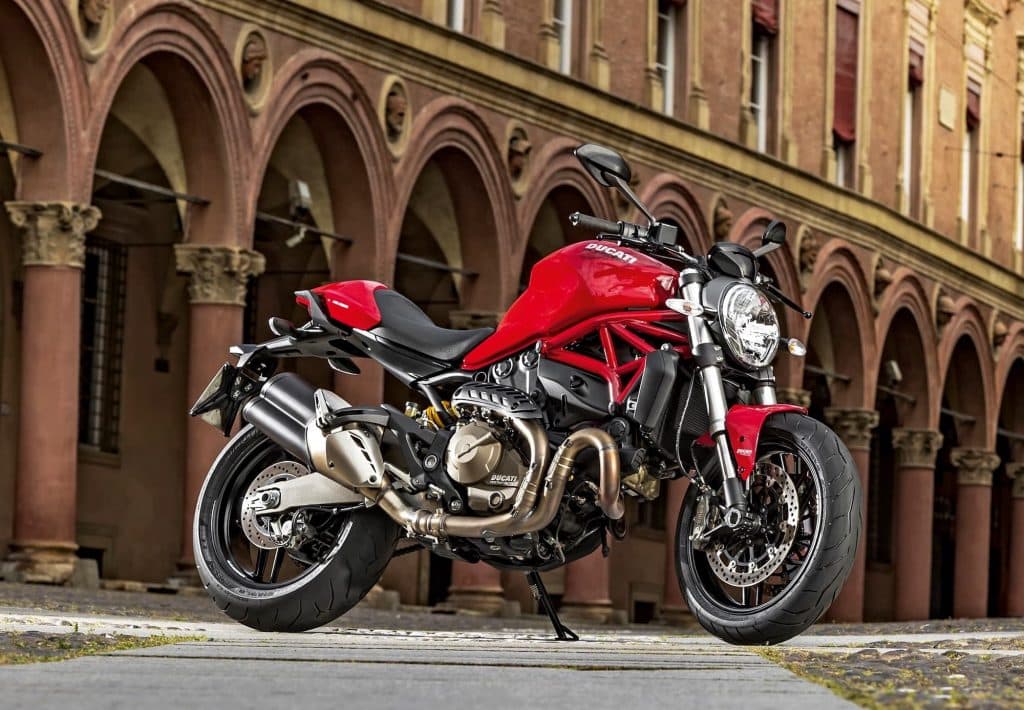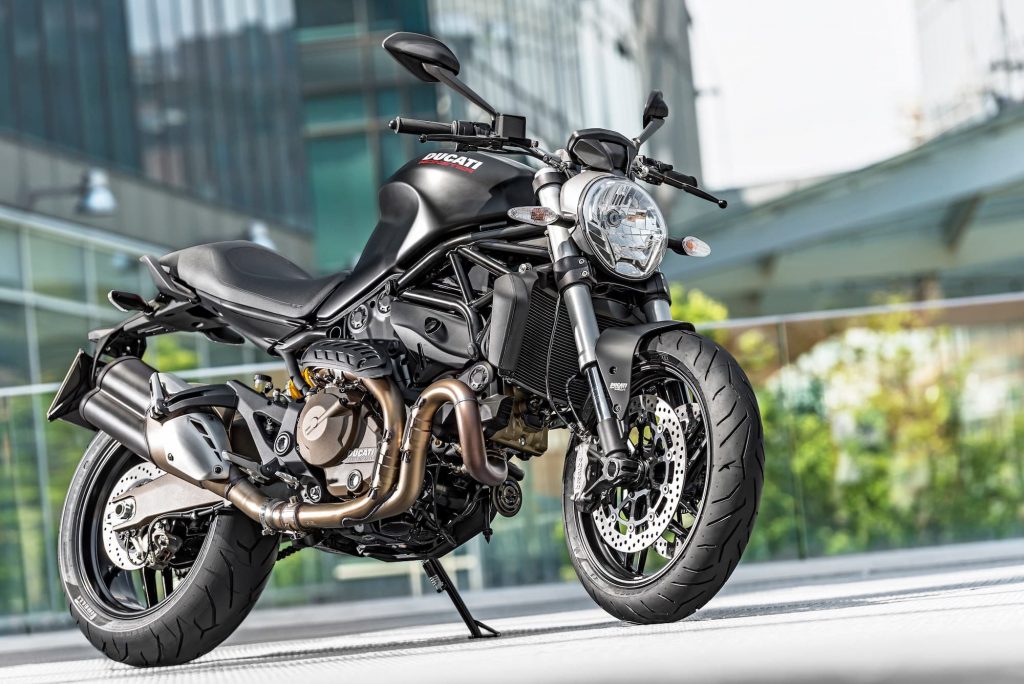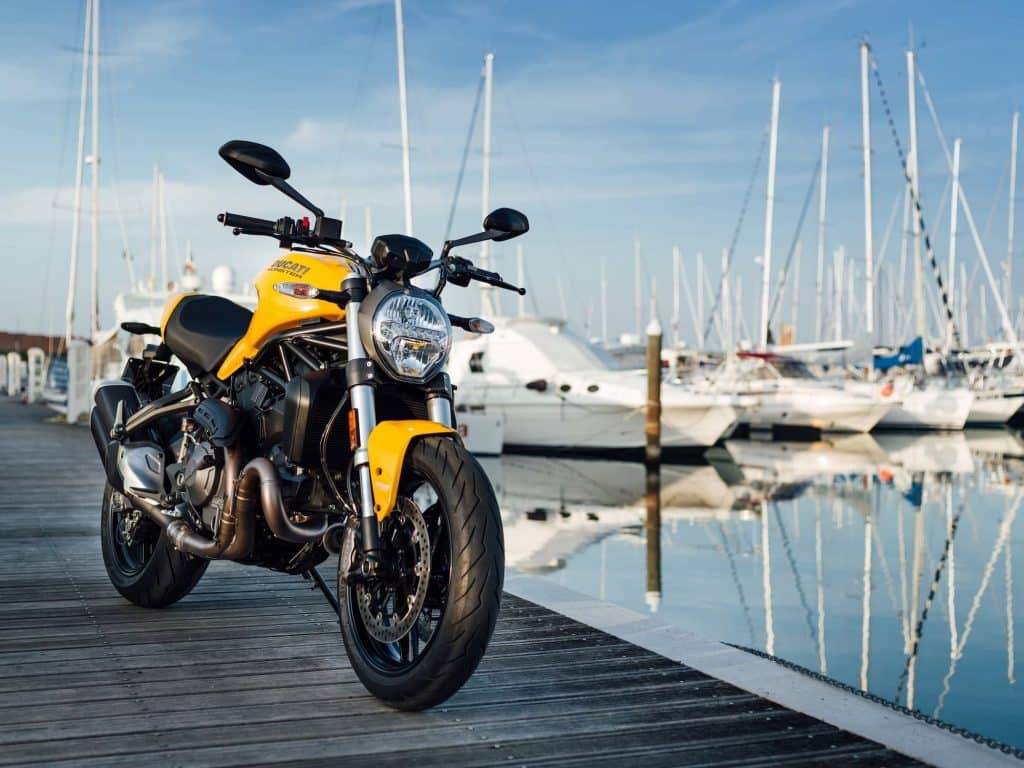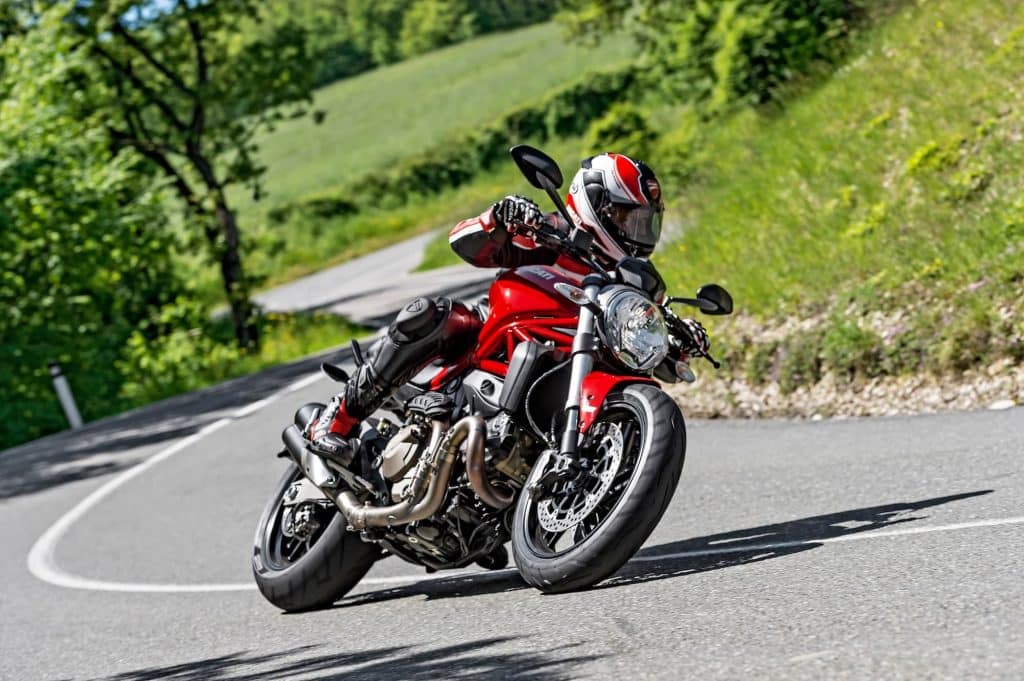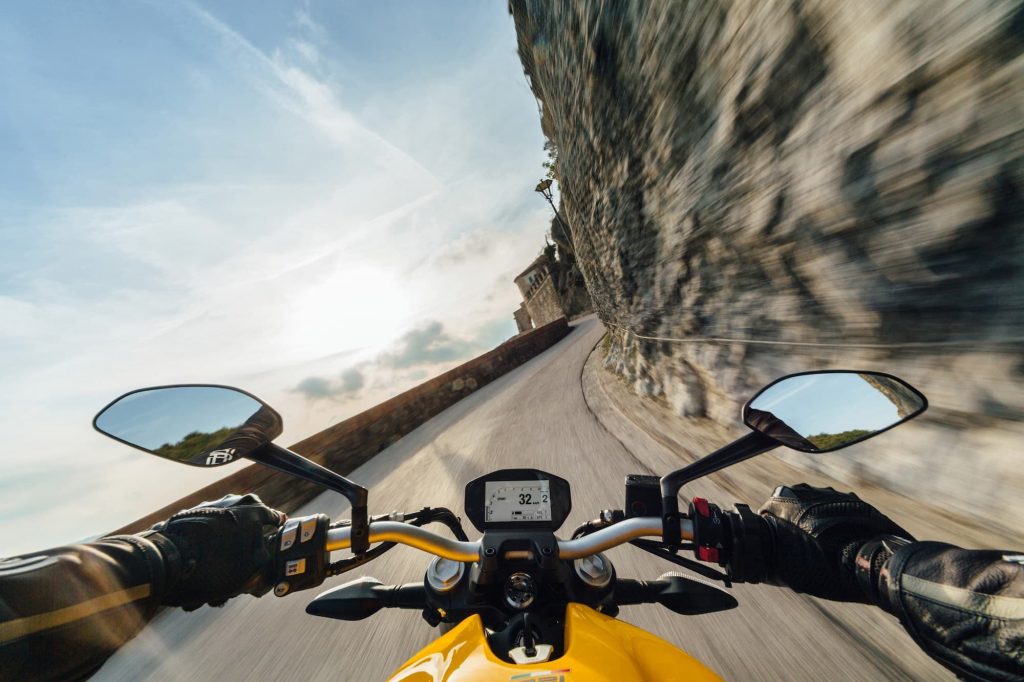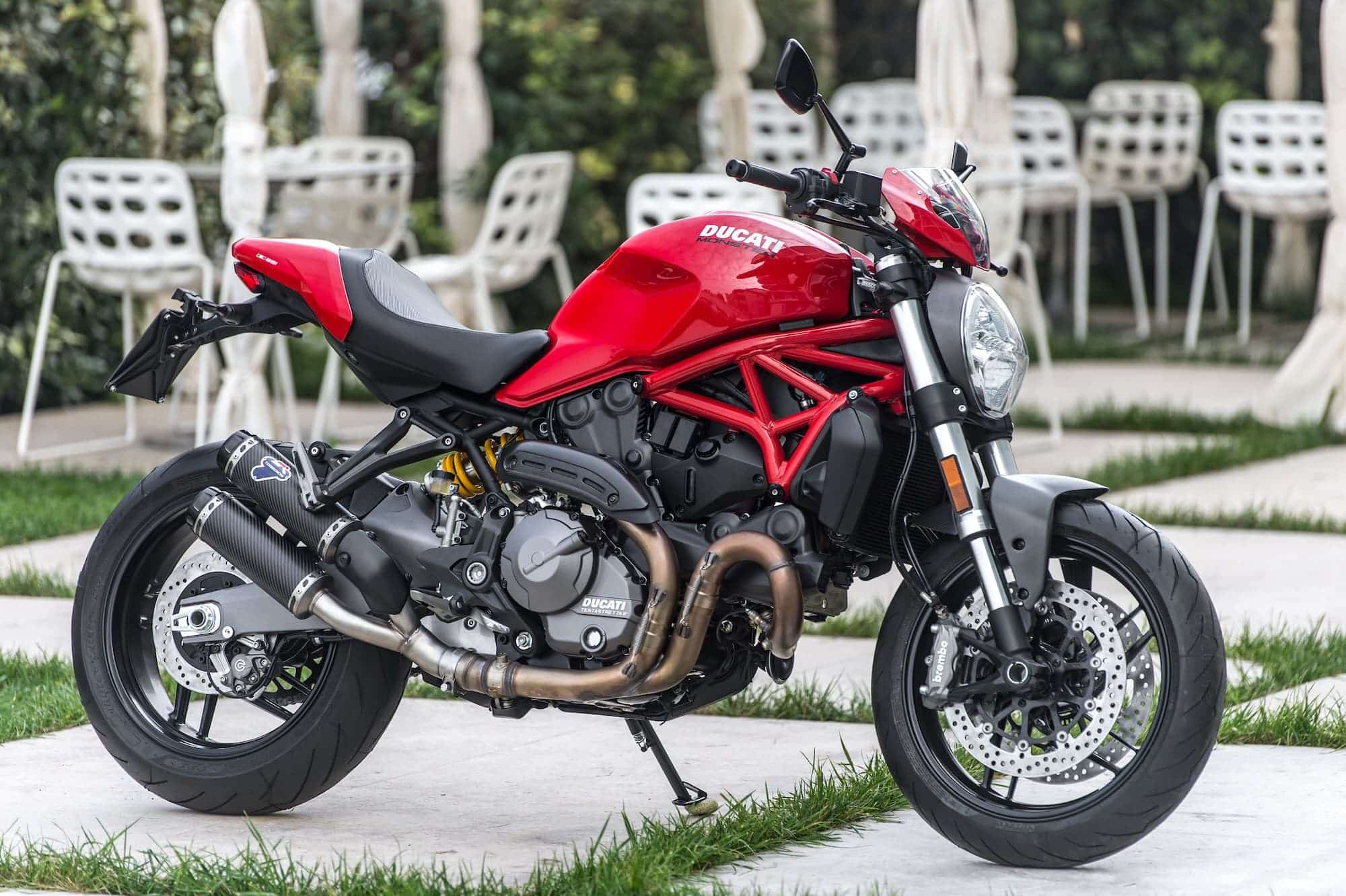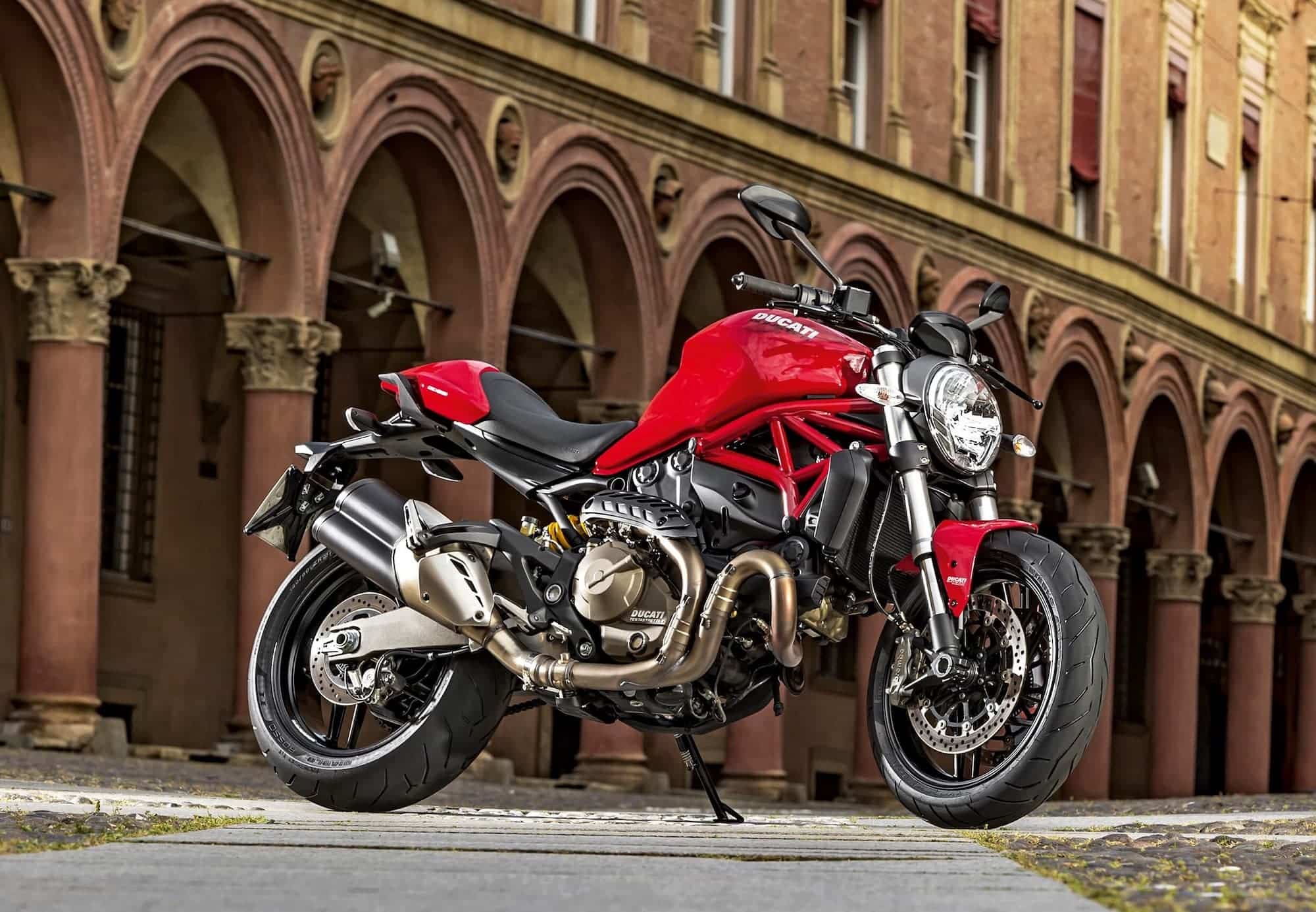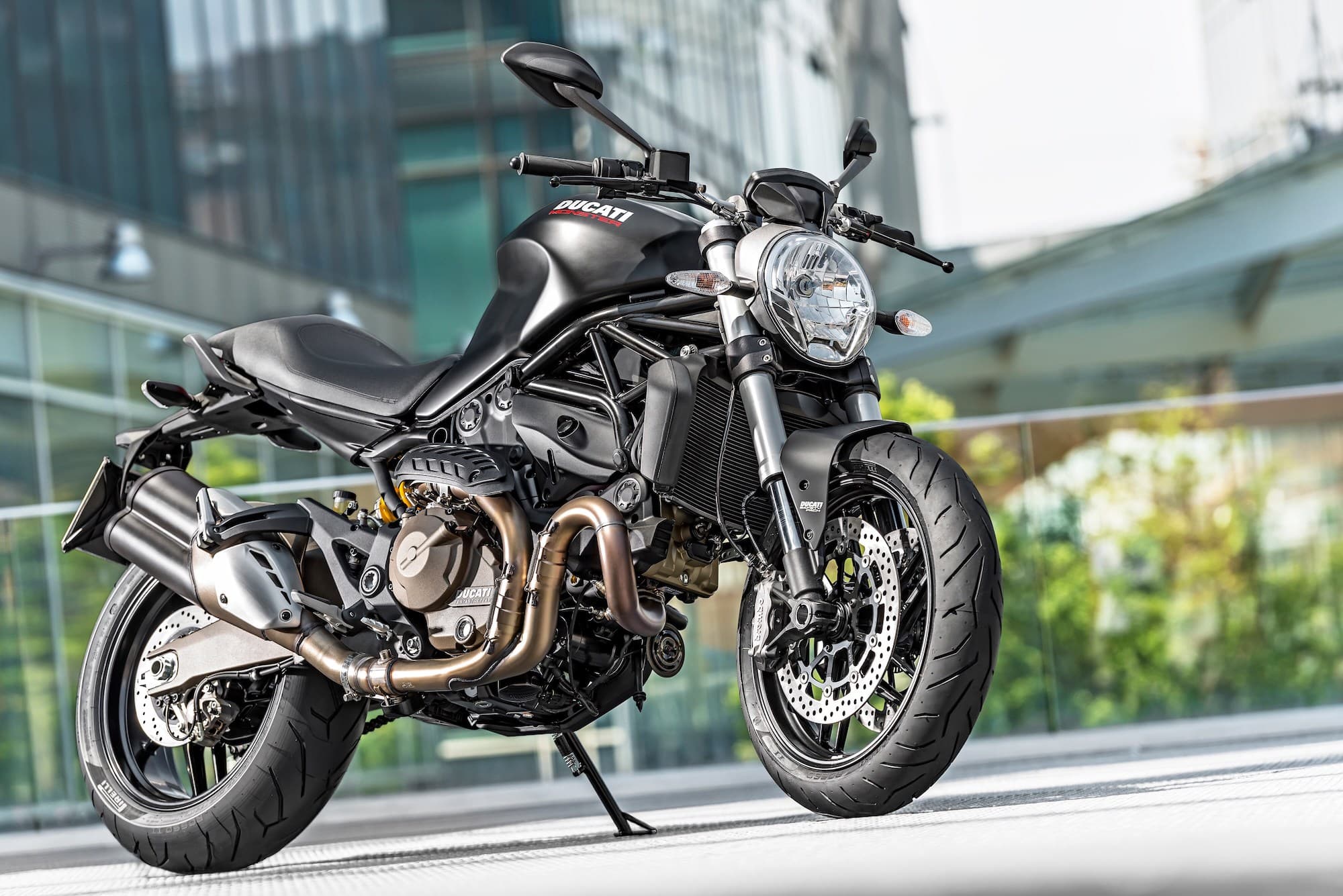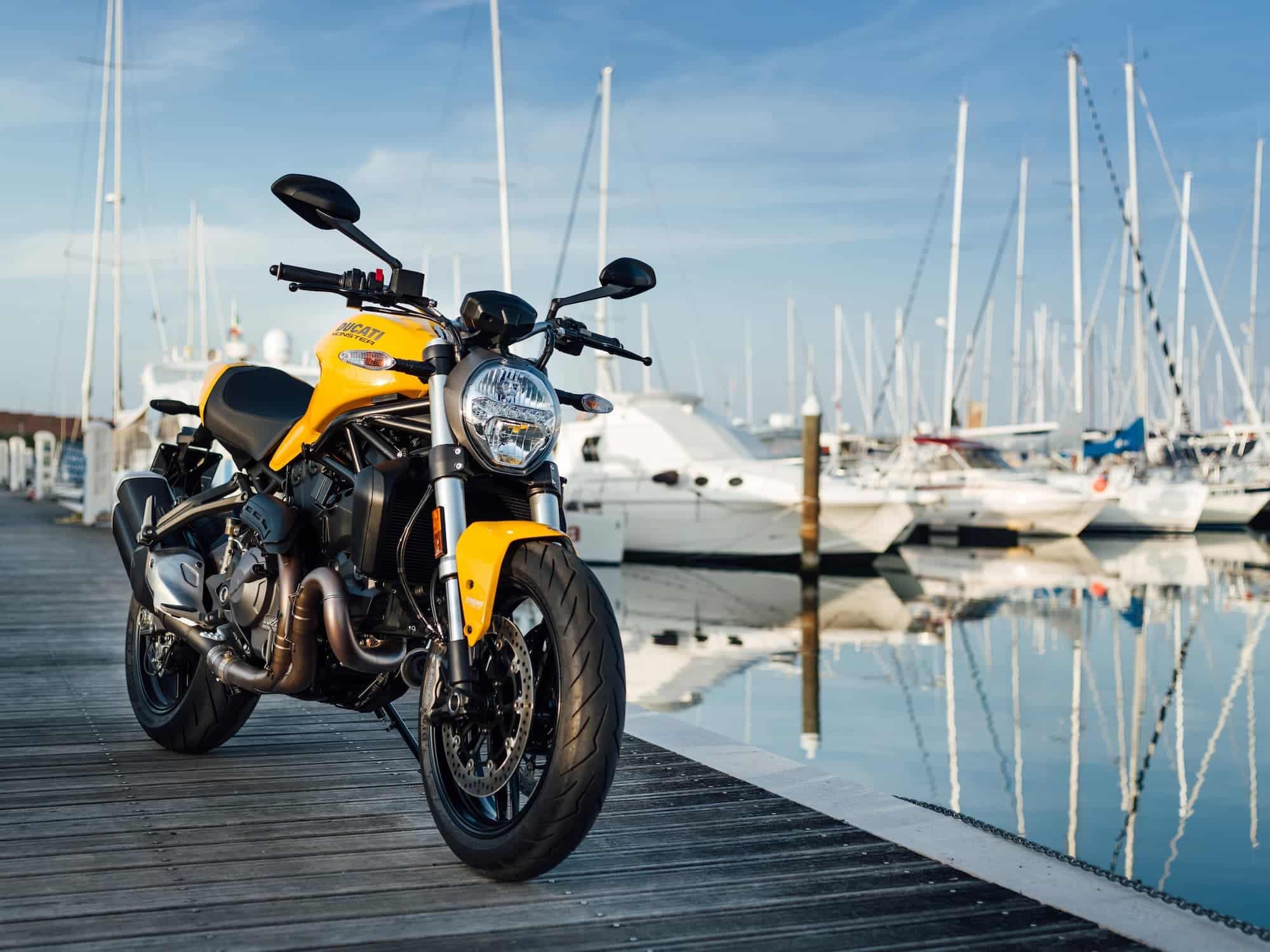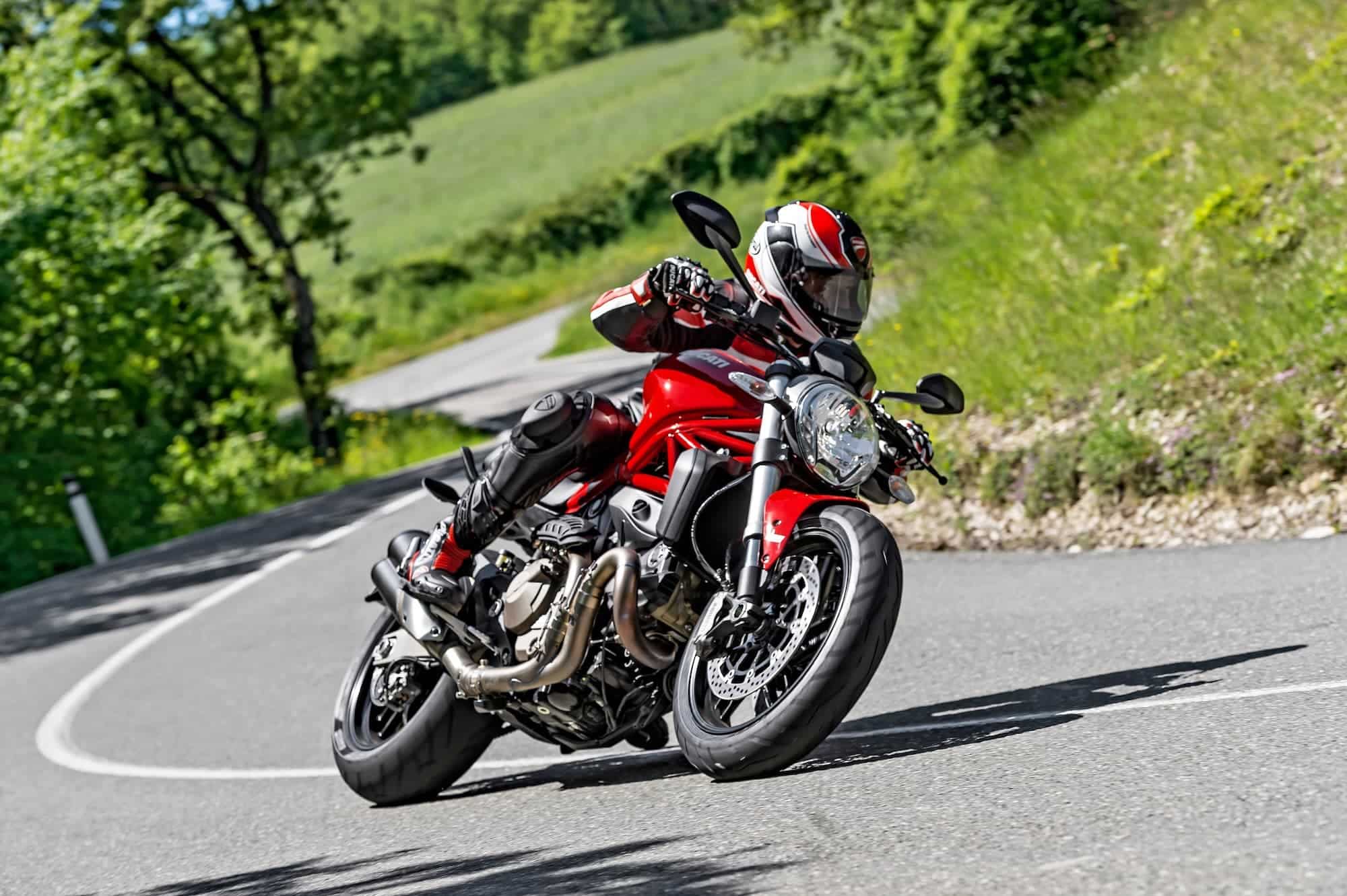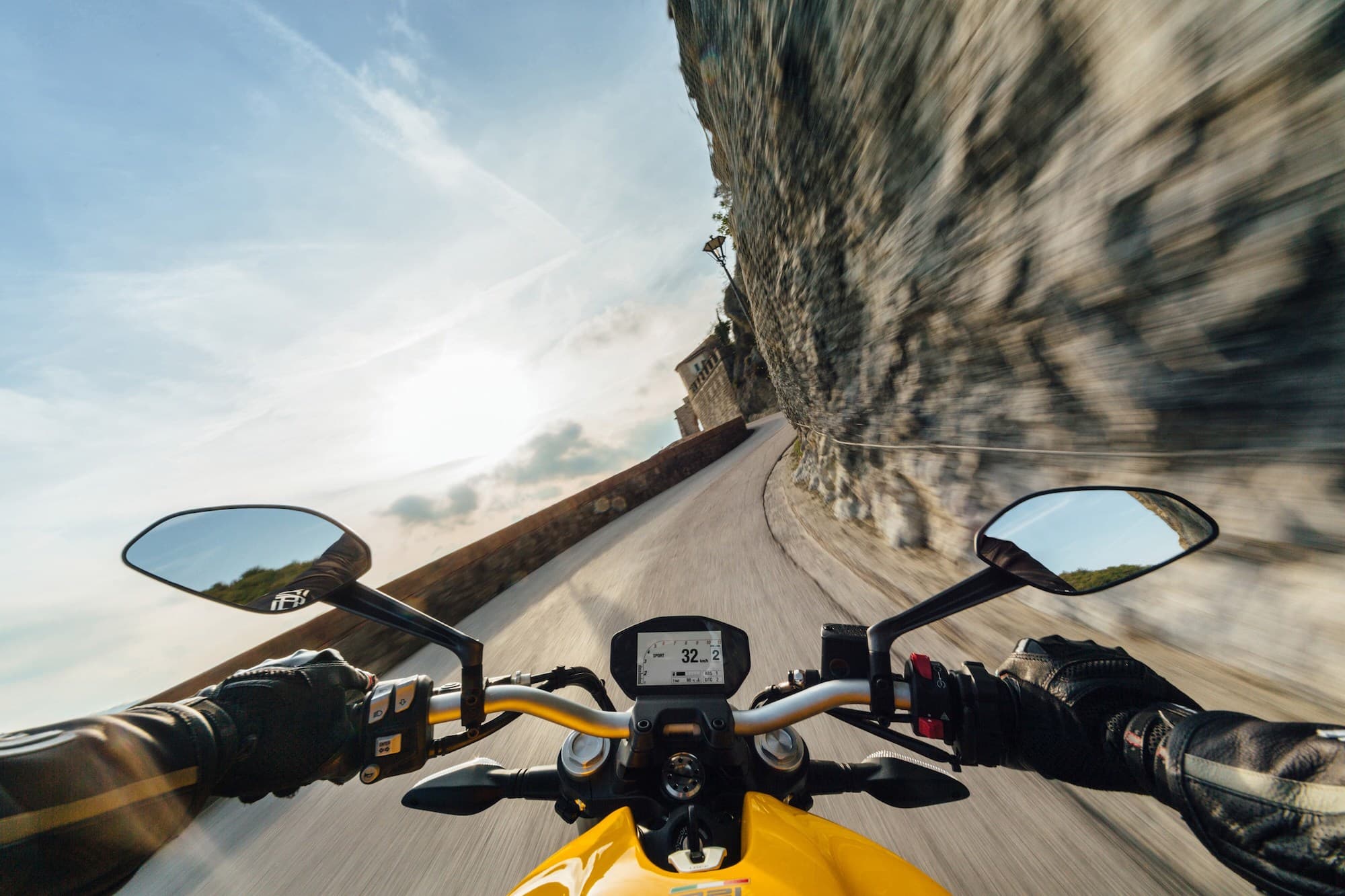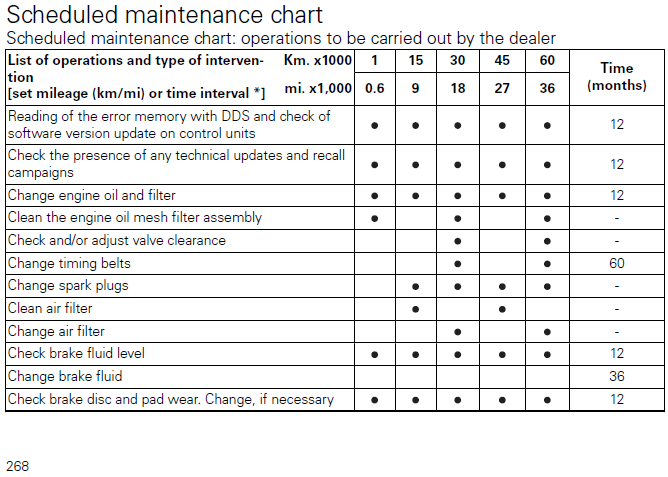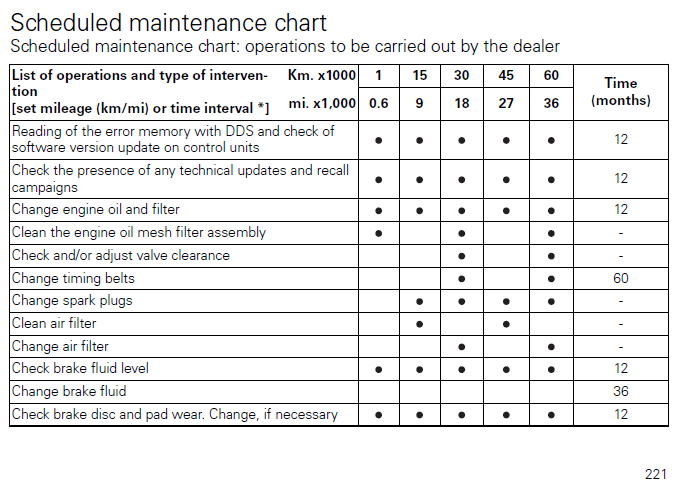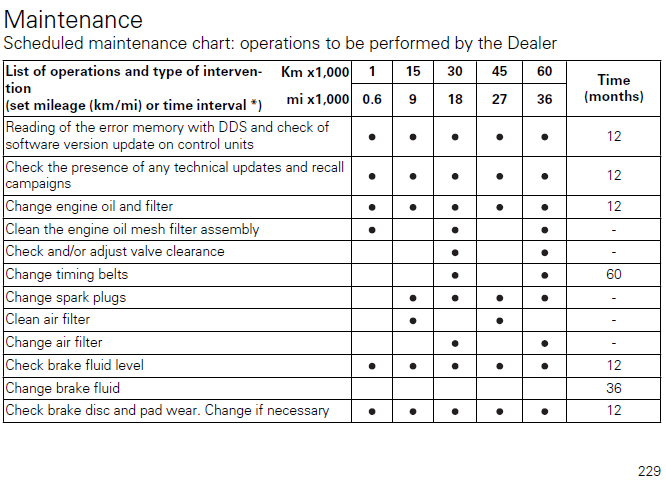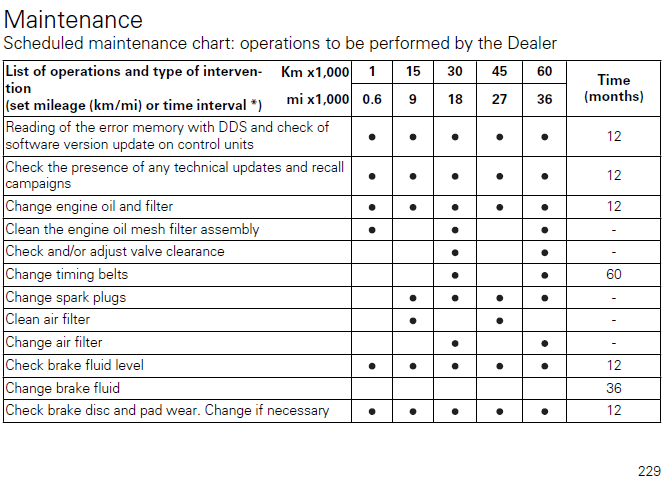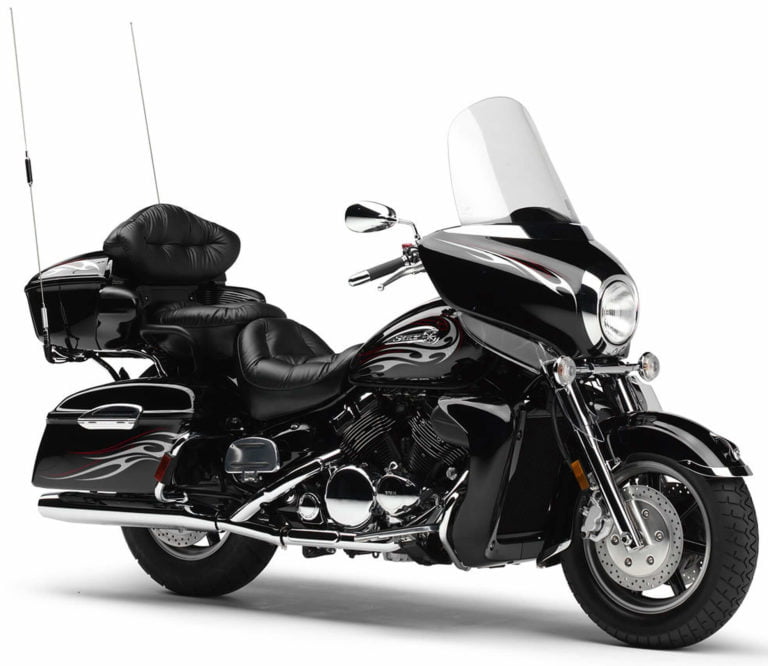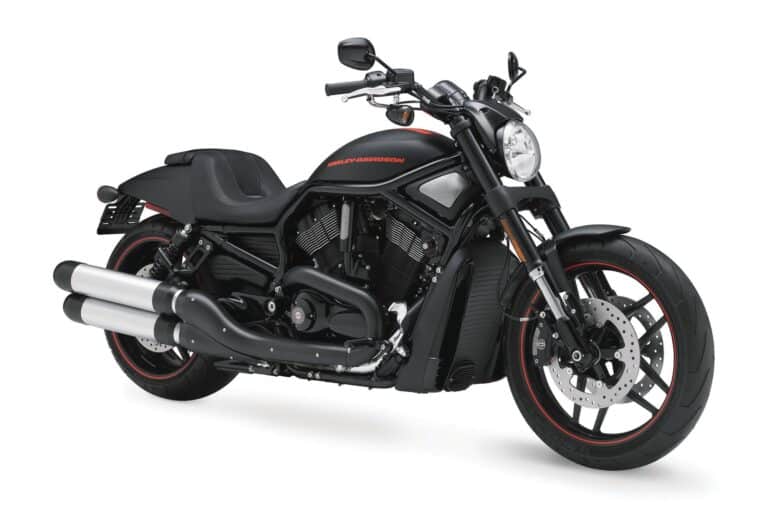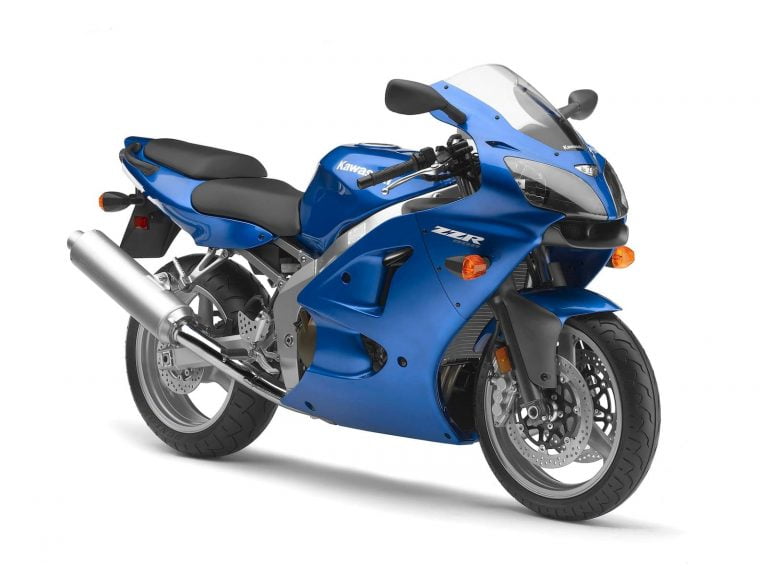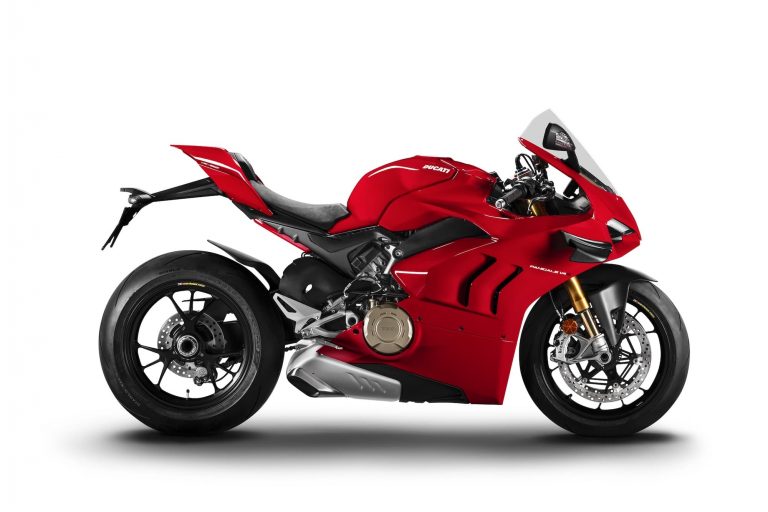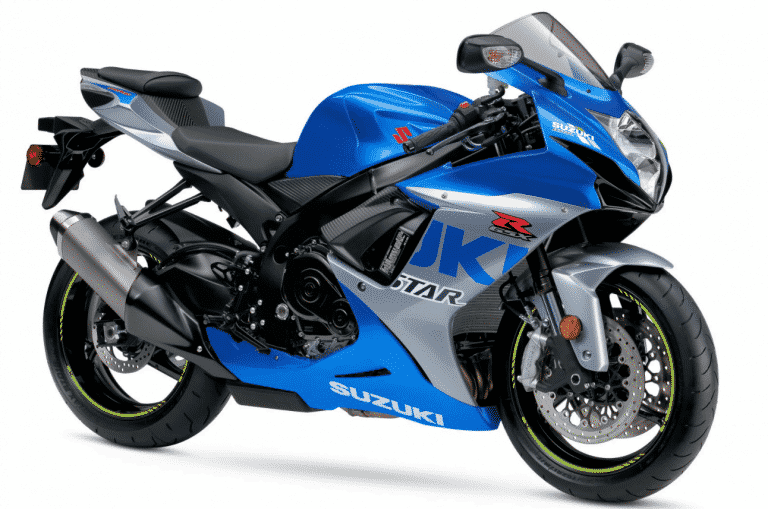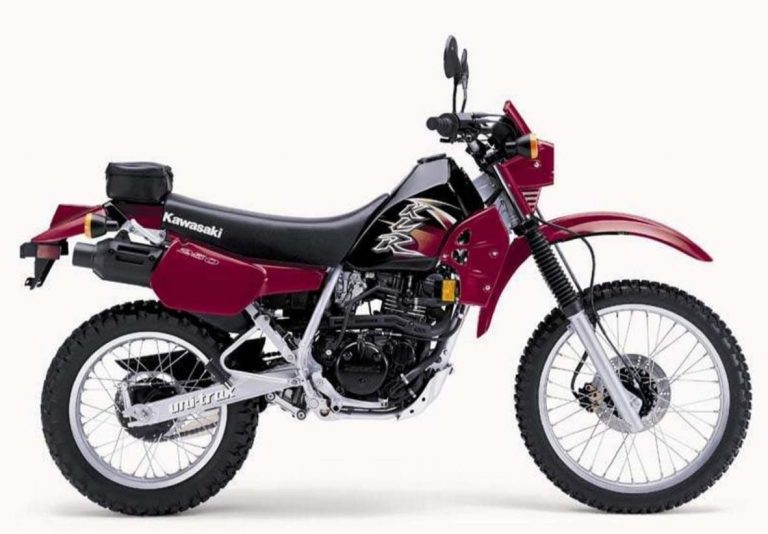Ducati Monster 821 (2015-2020, all models) Maintenance Schedule
This is the Ducati Monster 821 maintenance schedule and service intervals — sourced from the owner’s manual, and also referencing parts diagrams and the shop manual.
This applies to these models: the 2015, 2016, 2017, 2018, 2019 and 2020 Ducati Monster 821. It also applies to the Monster 821 Stripe, Monster 821 Stealth, and the Monster 821 Dark, which primarily had cosmetic differences, as well as some accessories and improved suspension on a couple (e.g., Stripe and Stealth).
Here are all our Ducati Monster maintenance schedules:
Air/oil-cooled Ducati Monsters
- Ducati Monster 900 (Carb)
- Ducati Monster 900 i.e. (EFI)
- Ducati Monster 800 (WIP)
- Ducati Monster 1000 / S
- Ducati Monster S2R800
- Ducati Monster S2R1000
- Ducati Monster 1100 (including S, Evo)
- Ducati Monster 659 Gen 1
- Ducati Monster 659 Gen 2
- Ducati monster 620 i.e.
- Ducati Monster 695
- Ducati Monster 696
- Ducati Monster 796
Liquid-cooled Ducati Monsters
- Ducati Monster S4
- Ducati Monster S4R
- Ducati Monster S4Rs
- Ducati Monster 821
- Ducati Monster 797
- Ducati Monster 1200 (2014-2016), and Monster 1200 S 2014-2016
- Ducati Monster 1200 (2017+), and Monster 1200 S 2017+
- Ducati Monster 1200 R
- Ducati Monster 937 (including +)
- Ducati Monster SP
The Ducati Monster 821 was released in 2015 to replace the earlier Ducati Monster 796, which had an air/oil-cooled motor.
The Monster 821 has the same 821 Testastretta-11 engine that was in the Ducati Hypermotard 821 — an 821-cc liquid-cooled 8-valve 90-degree V-twin that in base form makes about 82 kW (111 bhp) at 9250 rpm.
It’s a great engine — but in terms of maintenance, the most important thing is that it has a wide (for Ducati) 18000 mile / 30000 km valve inspection interval. Considering that there are now four valves per cylinder as standard, this is a huge blessing!
The Monster 821 also has five-year belt replacement intervals, another large improvement over earlier manuals which required 2-year replacements (though most owners do it between four and five years anyway).
In 2021, the Monster 2021 was replaced with the new Ducati Monster and Monster+, which some refer to as the Monster 937, referring to the larger engine capacity.
This post was originally published on May 12, 2020, but has since been significantly updated.
This site has links for things like oil and spark plugs from which we earn a commission (which unfortunately nobody can save, not even us). If you appreciate this work, then please use those links. Thanks!
Ducati Monster 821 Service Intervals
The Ducati Monster 821 has 9000 mile / 15000 km or annual service intervals. At every service, change the engine oil and filter.
You should also change the spark plug at every oil service, and either clean or change the air filter.
The valve service intervals are every 18000 miles or 30000 kms. At these services, check the valve clearances and also change the timing belts.
If you don’t do that mileage in five years change the timing belts at the five year point.
What you need to maintain the Ducati Monster 821
Aside from general motorcycle maintenance tools, the following is a list of consumables (things like oil, spark plugs etc.) you need to maintain the Ducati Monster 821.
| Item | Ducati Monster 821 spec |
|---|---|
| Oil | Ducati recommends Shell Advance Ultra 15W-50 motorcycle oil, or another high-quality synthetic motorcycle oil like Motul 7100 15W-50 or Mobil 1 Synthetic 15W-50. |
| Oil filter | Genuine Ducati part is 44440037A. I’d suggest removing that and using a HifloFiltro HF153RC oil filter which can be changed with a normal wrench. |
| Brake fluid, Clutch fluid | Ducati recommends Shell Advance DOT 4, but that’s quite hard to find, so Castrol DOT 4 Synthetic is a good and very high-quality alternative. |
| Coolant | Ducati recommends Shell Advance Coolant or a 35-40% mix of Glycoshell, a low-silicate, and nitrite-, amine-, and phosphate-free coolant. Motorex M3.0 is a suitable alternative. |
| Timing belt | Is it time to change the timing belt? Don’t put it off… a broken timing belt will cost you a lot! You need part number 73740252A (and you need two). |
| Front brake pads | Standard brake pads code is 61341021A. You can also use EBC FA630HH for more bite/feel. |
| Rear brake pads | Use original part number 61340951A, EBC part number FA266HH for more bite/feel (and availability online) |
| Spark plugs | NGK code MAR9A-J. Note they’re sold individually (and you have two cylinders). |
| Air filter | The part number for the air filter is 42610191A. You can also use K&N DU-1006. |
You may also need the following general consumables to maintain your Monster 821.
| Description |
|---|
| Paddock Stand — Makes maintaining your chain or doing other maintenance much easier. |
| Motul chain paste — one of the most highly-regarded chain lubes. Easy to apply, doesn’t fling off. If you need more stuff, get the Motul chain care kit as an affordable package. |
| Always good to have on hand lithium soap-based grease for lubing external pivot points (like the swingarm) and bearings. |
| Use Protect all cable life to lubricate your cables and controls. |
Regular maintenance for the Ducati Monster 821
This is maintenance that you can do yourself (though the manual says you need a dealer to do it).
Using the motorcycle under extreme conditions, such as very damp and muddy roads or dusty and dry environment, could cause above-average wear of components like the drive system, the brakes or the air filter. If the air filter is dirty, the engine could get damaged. So replace/maintain those more often if you put them under duress.
Every 1 000 km / 600 miles OR 6 months (whichever comes earlier), perform the following maintenance:
| Monster 821 regular maintenance (every 1000 km / 600 mi or 6 months) |
|---|
| Check engine oil level (top up with Shell Advance Ultra if required) |
| Check brake fluid level (Castrol DOT 4) |
| Check tyre pressure and wear |
| Check the drive chain tension and lubrication (lubricate with Motul chain paste) |
| Check brake pads, replacing if necessary (front: 2x EBC FA630HH, rear: EBC FA266HH) |
Ducati Monster 821 Maintenance Schedule Table
The following is the list of maintenance operations and to be done on this motorcycle with a distance or time interval — whichever comes earlier. This maintenance schedule is in the same format as in the manual, though altered to fit this screen.
Notes
- If you ride your motorcycle off road or in dirty or wet conditions, you might have to do maintenance more frequently than scheduled, particularly on the air filter and chain.
- Past the end of the maintenance schedule, keep following it in the pattern shown
- Since the 821 is no longer sold new, the break in schedule is not shown below.
| Km x 1000 | 15 | 30 | 45 | 60 | Every |
|---|---|---|---|---|---|
| mi x 1000 | 9 | 18 | 27 | 36 | (Months) |
| Conduct standard Ducati annual service (see below) | ✓ | ✓ | ✓ | ✓ | 12 |
| [D] Check the presence of any technical updates and recall campaigns | ✓ | ✓ | ✓ | ✓ | 12 |
| Change engine oil and filter (Shell Advance Ultra oil, HF153RC filter) | ✓ | ✓ | ✓ | ✓ | 12 |
| Clean the engine oil mesh filter assembly | ✓ | ✓ | – | ||
| Check and/or adjust valve clearance | ✓ | ✓ | – | ||
| Change timing belts (73740252A) | ✓ | ✓ | 60 | ||
| Change spark plugs (NGK MAR9A-J) | ✓ | ✓ | ✓ | ✓ | – |
| Clean air filter | ✓ | ✓ | – | ||
| Change air filter (DU-1006) | ✓ | ✓ | – | ||
| Check brake fluid level | ✓ | ✓ | ✓ | ✓ | 12 |
| Change brake fluid (Castrol DOT 4) | 36 | ||||
| Check frame-to-engine fasteners tightening | ✓ | ✓ | ✓ | ✓ | – |
| Check wheel hub bearings | ✓ | ✓ | – | ||
| Check steering bearings and lubricate, if necessary | ✓ | ✓ | – | ||
| Change front fork fluid | ✓ | – |
Ducati Standard Annual Service
Below is the standard annual service checklist. Do these service items according to the maintenance schedule.
Items marked [D] require dealer-specific tools/resources
| Ducati Standard Annual service |
|---|
| [D] Read the error memory with DDS and check of software version update on control units |
| [D] Check the presence of any technical updates and recall campaigns |
| Check brake fluid level |
| Change brake fluid (Castrol DOT 4) |
| Check brake disc and pad wear. Change, if necessary |
| Check the proper tightening of brake calliper bolts and
brake disc flange screws |
| Check the proper tightening of the rear brake disc and phonic wheel bolts (with removal of rear wheel shaft, if necessary) |
| Check front and rear wheel nuts tightening |
| Check the proper tightening of final drive front and rear
sprocket nuts |
| Check final drive (chain, front and rear sprocket) and sliding shoe wear |
| Check final drive chain tension and lubrication (Motul chain paste) |
| Visually check the front fork and rear shock absorber seals |
| Check the freedom of movement and tightening of the side and central stand (if any) |
| Visually check the fuel lines |
| Check rubbing points, clearance, freedom of movement and positioning of hoses and electric wiring in view |
| Check the free play of clutch lever |
| Lubricate the levers at the handlebar and pedal controls |
| Change coolant |
| Check the coolant level and check circuit for damage |
| Check tyre pressure and wear |
| Check the battery charge level |
| Check the operation of all electric safety devices (side stand sensor, front and rear brake switches, engine kill switch, gear/ neutral sensor) |
| Check lighting, turn indicators, horn and controls |
| [D] Reset the Service indication through the DDS |
| Final test and road test of the motorcycle, testing safety devices (ex. ABS and DTC), electric fans and idling |
| Softly clean the motorcycle |
| [D] Fill out that the service was performed in on-board documentation (Service Booklet) |
Checking and Adjusting Chain Tension
Ducati requires that you regularly check the chain tension and lubrication level.
To check the chain tension, measure the distance between the chain and the swing-arm. Follow this procedure:
- Put the motorcycle on its side stand
- Push the chain down (bottom segment) and release it.
- Measure the distance between the centre of the chain pins and the metal part of the swing arm.
- Repeat this process of measurement for several points on the chain by moving the motorcycle around.
Target drive chain slack: 28-30mm (1.1-1.2 in)
If the slack is out, adjust tension to bring it back into spec. You’ll need a breaker bar for the rear axle and a large torque wrench (that can do up to 200 Nm / 150 lb-ft).

- Loosen the axle nut.
- Loosen the lock nuts on the adjuster nuts on either side of the axle.
- Turn the adjuster nuts to move the wheel backwards, tightening up the chain. pay attention to the adjuster markings. Make sure the wheel is aligned on both sides by ensuring that the adjuster markings are the same on either side.
- Grease the wheel shaft nut thread with Shell Retinax HDX2 and tighten it, together with the axle nut on the right hand side, to 180 Nm (133 lb-ft).
- Grease the adjuster screws with Shell Alvania R3 and tighten them to 10 Nm (7 lb-ft).
Ducati Monster 821 Tire Sizes and Recommended Pressures
The Ducati Monster 821 is a street sport bike, so would be good with anything from road tires through to sport tires with a minimal street-legal pattern. It runs a very conventional sport tire size, so there is a wide variety of tires available.
Here are the specified tire sizes and recommended starting point tire pressures.
| Wheel | Tire size | Tire pressure (cold) |
|---|---|---|
| Front | 120/70-ZR17 | 2.3-2.5 bar / 230-250 kPa / 33-36 psi |
| Rear | 180/55-ZR17 | 2.5-2.8 bar / 250-280 kPa / 36-41 psi |
Naturally, adjust the tire pressures as suit your riding style.
About the Ducati Monster 821
At its core, the Ducati Monster 821 is still the same bike it has always been — a middleweight naked sport bike that isn’t as aggressive as the Streetfighter range, but not as docile as for example a Triumph Bonneville.
That’s the spirit of the Ducati Monster 821. An everyday bike that has Ducati spirit, but which isn’t overbearing to ride.
The Monster 821 carries on the legacy first set by the Ducati Monster 900 back in 1993. That bike was conceptually similar — a naked motorcycle with a middleweight engine that doesn’t need to be screamed at high RPM.
But the Ducati Monster 821 is a huge tech update on early Ducati Monsters, as well as an aesthetic redesign. The 821 gains a four valve per cylinder engine (up from two) and liquid cooling (Ducati Monsters were air/oil-cooled before this).
The Ducati Monster 821’s engine makes a feisty 112 hp / 82.4 kW peak at 9250 rpm, with 66 lb-ft / 89 Nm of torque at peak at 7750 rpm. That’s a lot more power and even torque than the original Monster 900!
The Ducati Monster 821 also has a standard wet clutch. This was true of the “smaller” Ducati Monsters of the past (e.g. the 796 and 800), but the Monster 821’s impressive power, far ahead of the original Monster 900, means this is no longer a small motorcycle, but rather a capable sport bike.
The Ducati Monster 821 in base trim comes with a KYB 43-mm upside down fork, and a Sachs monoshock that has rebound and spring preload adjustability. The Monster 821 also came in a number of other trims (e.g. Stripe, Stealth) with fully adjustable front suspension.
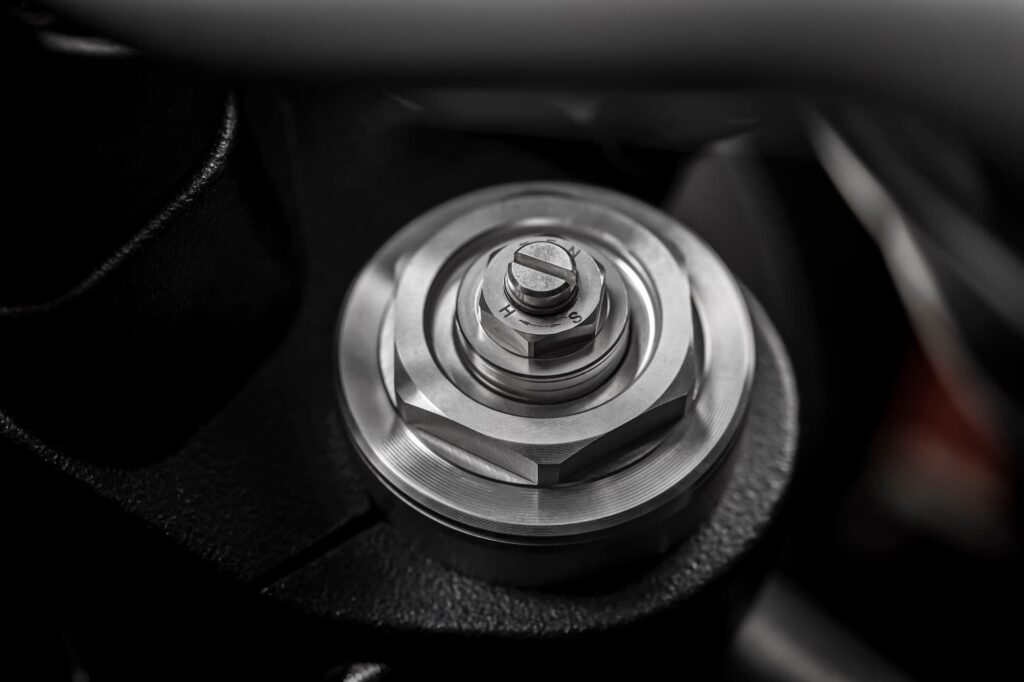
The front brakes are dual 320mm discs with Brembo M4.32 calipers on them — pretty standard fare for high-end street bikes, and very capable.
One of the benefits of the liquid-cooled engine in the Ducati Monster 821 is the wide service intervals. While you change the oil every 15000 km / 9000 miles, valves only need to be serviced every 30000 km / 18000 miles. This set a new standard for Ducati, bringing them in line with most manufacturers in recommended valve service intervals.
Of course, when you service the valves on a Ducati it’s more involved (it’s still a Desmo engine — meaning twice as many clearances to check), and usually a shim or two needs replacing.
The valve service in Ducati motorcycles is in contrast with most Japanese sport bike engines, which typically have a) inline engines (only one cylinder head), b) have spring valve reseating mechanism (so fewer clearances to check), and c) often don’t need any adjustments done, particularly after the first service.
For those who want a little more aggression, the Monster 821 had a big brother, the Ducati Monster 1200, which got a lot more power, tech, and some more weight.
In 2018, Ducati revised the Monster 821 somewhat, with a new tank, tail section, headlight, and muffler. The intention was to make it more “classic” looking, like the original Monster 900. The engine however stayed the same, as did the basic maintenance.
In 2021, Ducati replaced the Ducati Monster 821 with a motorcycle simply known as the Ducati Monster, but which people refer to as the Ducati Monster 937.
It shares its 937-cc engine with motorcycles like the Ducati Supersport.
Reference — Ducati Monster 821 Owner’s Manual
The above info was sourced from the owner’s manual for the Ducati Monster 821, consulting various years and trim levels. See screenshots below for reference.
You can download it from the Ducati website here. An archive copy of the manual is also below.
